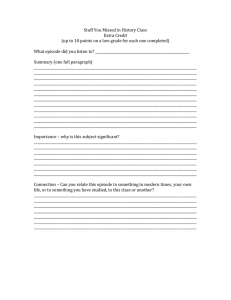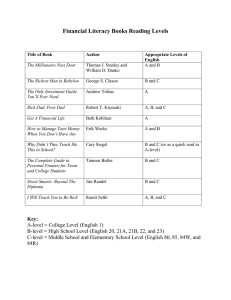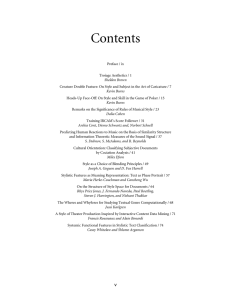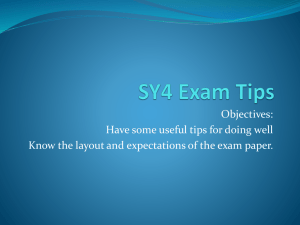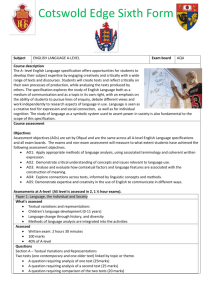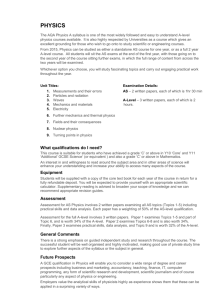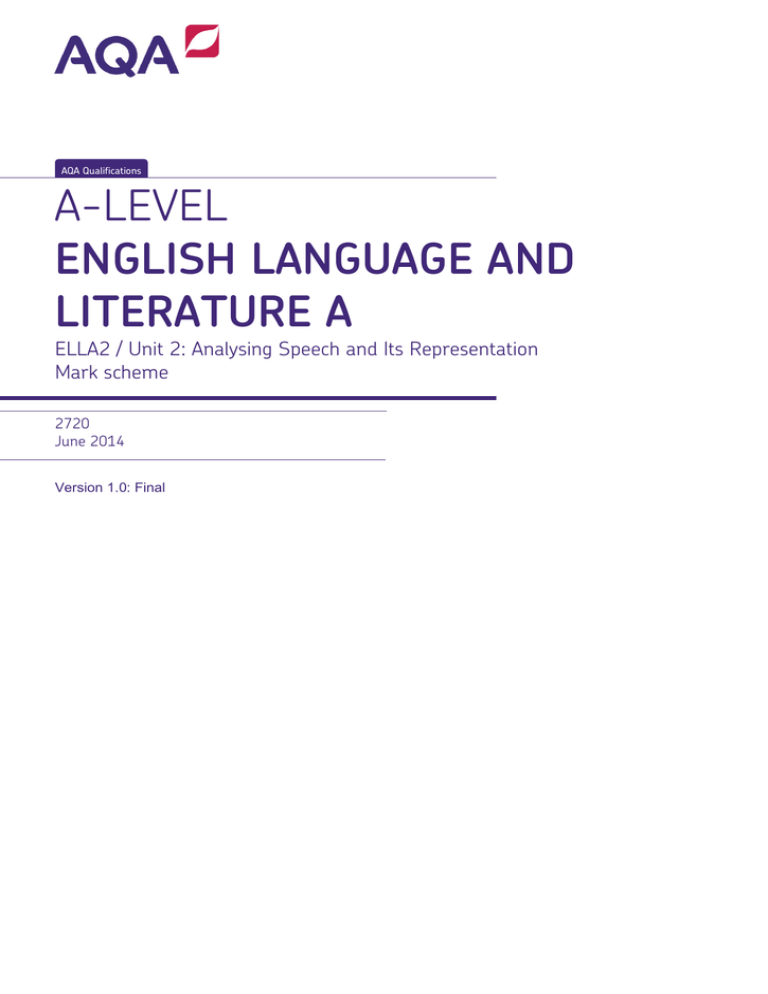
AQA Qualifications
A-LEVEL
ENGLISH LANGUAGE AND
LITERATURE A
ELLA2 / Unit 2: Analysing Speech and Its Representation
Mark scheme
2720
June 2014
Version 1.0: Final
Mark schemes are prepared by the Lead Assessment Writer and considered, together with the
relevant questions, by a panel of subject teachers. This mark scheme includes any amendments
made at the standardisation events which all associates participate in and is the scheme which was
used by them in this examination. The standardisation process ensures that the mark scheme covers
the students’ responses to questions and that every associate understands and applies it in the same
correct way. As preparation for standardisation each associate analyses a number of students’
scripts: alternative answers not already covered by the mark scheme are discussed and legislated for.
If, after the standardisation process, associates encounter unusual answers which have not been
raised they are required to refer these to the Lead Assessment Writer.
It must be stressed that a mark scheme is a working document, in many cases further developed and
expanded on the basis of students’ reactions to a particular paper. Assumptions about future mark
schemes on the basis of one year’s document should be avoided; whilst the guiding principles of
assessment remain constant, details will change, depending on the content of a particular
examination paper.
Further copies of this Mark Scheme are available from aqa.org.uk
Copyright © 2014 AQA and its licensors. All rights reserved.
AQA retains the copyright on all its publications. However, registered schools/colleges for AQA are permitted to copy material from this
booklet for their own internal use, with the following important exception: AQA cannot give permission to schools/colleges to photocopy any
material that is acknowledged to a third party even for internal use within the centre.
MARK SCHEME – A-LEVEL ENGLISH LANGUAGE AND LITERATURE A – ELLA2 – JUNE 2014
DISTRIBUTION OF ASSESSMENT OBJECTIVES AND WEIGHTINGS
The table below is a reminder of which Assessment Objectives will be tested by the questions and
the marks available for them.
Unit 2
Assessment Objective
Question 1
Questions 2 - 11
AO1
15
AO2
15
15
AO3
30
Note to examiners on question-specific mark schemes
Please note that the ideas and points given in each of the question-specific mark schemes are not
exhaustive and are only printed to give an idea of some of the points you might see when marking
scripts. Do not treat them as a checklist. Use them as a referral point with the opportunity to add
to them as you continue to mark.
3 of 23
MARK SCHEME – A-LEVEL ENGLISH LANGUAGE AND LITERATURE A – ELLA2 – JUNE 2014
Marking notations for English Language and Literature – ELLA2
Use the guidelines in the Assistant Examiner’s Handbook as the basis of your marking, but
supplement with these specific notations used across all units of the specification.
Points that are correct:
(tick):
ewm:
to indicate a positive point (but not rhythmical ticks)
engages with meaning
Errors:
mistakes:
pnm:
marked with X
point not made (if idea is not explained)
Marginal annotation:
gr:
style:
coh:
con:
pr:
for a grammatical point made
for a stylistic point made
for a cohesive point made
context understood, commented upon
personal response
att:
comp:
fos:
comment on speaker attitude(s)
comparison exemplified and commented upon
feature of speech or prepared speech noted,
commented upon
These points in no way supersede other marginal comments made by examiners. You should seek
to make meaningful but economic comments in the margins and, particularly, at the end of the
essay to show how your marks have been arrived at.
4 of 23
MARK SCHEME – A-LEVEL ENGLISH LANGUAGE AND LITERATURE A – ELLA2 – JUNE 2014
SECTION A
Question 1
Marking Procedure
1.
2.
3.
Assess each AO separately; use the grid to ascertain the relevant band, sub-band and then
mark.
Additional points and ideas will be added to the question-specific mark schemes during
standardisation.
Award mark for each AO, record at the end of the script and add together to arrive at a mark
out of 45 for Question 1. Ring mark and transfer to front of script.
5 of 23
MARK SCHEME – A-LEVEL ENGLISH LANGUAGE AND LITERATURE A – ELLA2 – JUNE 2014
MARKING GRID FOR AS ENGLISH LANGUAGE AND LITERATURE: SECTION A
13 – 15
Demonstrate detailed critical
understanding in analysing
the ways in which structure,
form and language shape
meanings in a range of
spoken and written texts
Use integrated approaches
to explore relationships
between texts, analysing
and evaluating the
significance of contextual
factors in their production
and reception
AO2
(Marks out of 15)
Profound analysis of literary or
linguistic texts; sense of
overview; illuminating reading
of text. Possibly
conceptualised or
individualistic in approach.
Conceptual comment on
cohesion and textual structure.
Cogent comments on features
of speech and how speech
works.
AO3
(Marks out of 30)
Assimilates and
contextualises references
with originality. Total
overview that may offer
observations on wider
contexts. Exploratory.
Significant similarities and
differences are made in an
original/personal, possibly
conceptual, manner. All texts
effortlessly compared with
attitudes assimilated.
26 – 30
Band 4
11 – 12
Secure and coherent reading
and analysis underpinned by
good textual evidence; textual
grasp very evident. Close
focus on details with a range
of examples discussed.
Coherent comment on form
and structure; thoughtful
points made on speech and
how it works.
23 – 25
Skilful and secure
comparison; clear sense of
context/variation/contextual
influences underpins reading.
Close focus on texts.
Coherently compares and
contrasts writer’s choices of
form, structure, mode,
language. Confident
comparison of attitudes.
6 of 23
MARK SCHEME – A-LEVEL ENGLISH LANGUAGE AND LITERATURE A – ELLA2 – JUNE 2014
9 – 10
Band 3
7–8
5–6
Band 2
4
Close reading and analysis
becomes obvious; some
exploration. Growing
confidence of interpretation.
Careful use of illustrated
points. Explains form and
structure accurately with
significant points about speech
features; some comment on
how speech works.
Responds with growing
confidence; analysis
emerging: appreciation of
style, structure and form
becoming apparent. May
concentrate on one area at
expense of others. Some
distinguishing features
commented upon; speech
features are commented upon
but may lack contextual
understanding.
Some simple analysis and
recognition of implied
meaning; at least two
illustrated points are made.
List-like in approach. Possibly
lacks evidence in places;
broader, list-like comments
may feature. Speech
comments will feature but will
be made simply and may
concentrate on straightforward
mode differences. Very little
contextual comment made.
Basic and generalised
analysis; responds to surface
features in a broad fashion.
May take a narrative approach
with occasional simplistic
comments. Lacks details or
engagement and very few
speech features, not related to
the context at all.
20 – 22
16 – 19
12 – 15
9 – 11
Expresses clearly
comparisons and contrasts
between two texts, clear
interplay between text and
context/sense of contextual
variation; comments clearly
on a variety of points/areas.
Comparison may be
imbalanced; possible
imbalance of text coverage
and/or attitudes.
Context commented on;
points are made but implicit
meanings are probably
shown; analysis may show
implicit meanings; some
comment on language use in
texts. Imbalance in coverage
of contexts, attitudes and
comparison.
Comparative framework used
but comparisons may be
partial and simplistic;
develops a line of argument
underpinned by comment on
overall context; probably listlike in construction.
Imbalance in coverage of
texts; lacks evidence in
places; perhaps no comment
on content. Simplistic
comments about attitudes.
May see how context
influences language use;
general awareness of writer’s
techniques and impact on
meaning. Responds to
obvious or broad links or
comparisons. Sometimes
comments on less important
links. Lacks detail and
evidence especially regarding
attitudes.
7 of 23
MARK SCHEME – A-LEVEL ENGLISH LANGUAGE AND LITERATURE A – ELLA2 – JUNE 2014
3
Band 1
1–2
A little understanding; very
limited analysis; sometimes
responds to surface
features/odd textual
references but main focus is
on textual narrative or general
points. Speech points are
totally general.
A little awareness of text but
form and structure are
ignored. Erroneous use of
speech terms.
Possibly skimpy reading; no
analysis; no engagement with
meaning at bottom of band.
7–8
Superficial idea of context.
Occasional insight but not
sustained; one area of study
noted, others are ignored. No
comparisons made, very
limited awareness of details
and probably little evidence
used.
Very little awareness of
context; very limited ideas.
Very superficial.
1–6
Contextual features identified
erroneously with misreading
at bottom of band.
8 of 23
MARK SCHEME – A-LEVEL ENGLISH LANGUAGE AND LITERATURE A – ELLA2 – JUNE 2014
Question 1
01
Read Texts A and B.
Text A is a transcript of Helen, an amateur naturalist, talking to her friend Alan about the
importance of woodlands.
Text B is an article from The Guardian newspaper online about a serious disease
affecting ash trees in the UK.
Compare how information and attitudes about the future of British woodlands are
conveyed by the speakers in the two texts.
In your answer you should comment on:
•
•
vocabulary, and grammatical, stylistic and speech features
the influence of context on the ways in which speakers convey attitudes and
ideas.
(45 marks)
Assessment Objectives tested on this question: AO2 and AO3
Some possible content/stylistic points candidates may refer to:
• information in Text A is a transcript of spontaneous speech: Text B has been prepared as a
newspaper report using various sources
• information in Text A is delivered through first person: Text B uses a mixture of reported and
direct speech and short quotations from sources
• both texts give some background information e.g. Text A gives information about the amount
of woodland left, Text B says that 30% of all UK woodland is at risk
• discourse features remain in Text A and show the spontaneous nature of the text.
• the use of some technical terms to describe tree diseases in Text A e.g. ‘Dutch Elm disease’,
‘Sudden Oak Death’, ‘eco-system’. Technical terms are also used in Text B, e.g. ‘dieback’.
‘Chalara fraxinea fungus’
• both texts use statistics to support the points they make
• lexis to evoke a sense of the seriousness of the situation, e.g. in Text A, ‘wiped out’,
‘devastating’, ‘catastrophe’ and in Text B, ‘fatal’, ‘epidemic’, ‘deadly disease’, ‘national
tragedy’
• language used to create a sense of an urgent response in Text B, e.g. the use of the
metaphor ‘a call to arms’, ‘emergency summit’, ‘taskforce’, ‘urgent and clear advice’
• the use of repetition in Text A to emphasise the potential effects of large-scale tree loss, e.g.
‘devastating’
• use of emphasised words in Text A to express feelings, e.g. ‘over 40 per cent’, ‘massive’,
‘me’, ‘catastrophe’
• back-channelling in Text A e.g. ‘yeah’, ‘hmmm’ and some sense of disagreement in Text B,
e.g. ‘criticised the government’, ‘called for an emergency summit’.
Examiner notes
9 of 23
MARK SCHEME – A-LEVEL ENGLISH LANGUAGE AND LITERATURE A – ELLA2 – JUNE 2014
SECTION B
Questions 2 – 12
Marking Procedure
1.
2.
3.
Assess each AO separately; use the grid to ascertain the relevant band, sub-band and then
mark.
Additional points and ideas will be added to the question-specific mark schemes during
standardisation.
Award 15 marks for AO1 and AO2, record at the end of the script and add together to arrive at
a mark out of 30. Ring mark out of 30 and transfer to front of script.
10 of 23
MARK SCHEME – A-LEVEL ENGLISH LANGUAGE AND LITERATURE A – ELLA2 – JUNE 2014
MARKING GRID FOR AS ENGLISH LANGUAGE AND LITERATURE: SECTION B
13 – 15
Band 4
11 – 12
9 – 10
Band 3
7–8
Select and apply relevant
concepts and approaches from
integrated linguistic and literary
study, using appropriate
terminology and accurate,
coherent written expression
Demonstrate detailed critical
understanding in analysing the
ways in which structure, form
and language shape meanings in
a range of spoken and written
texts
AO1
(Marks out of 15)
Use of framework(s) enhances and
illuminates textual interpretation.
Has a possible overview of the text
through the framework(s). Engages
closely with the meaning of the
text; patterns fully appreciated.
Possibly conceptual in use of
framework(s). Fluent, cohesive
writing.
Coherent use of framework(s);
some thoughtful probing of features
and, possibly, patterns. Thoughtful
engagement with texts through
framework(s) and details.
Interpretation evident through
approach taken/framework(s) used.
Fluent writing.
Uses framework(s) to highlight
reading. Describes significant
features/patterns. Awareness of
stylistic and linguistic features.
Engages with texts through
explanation of features; possibly
underdeveloped in places. Clear
and appropriate writing.
AO2
(Marks out of 15)
Profound analysis of literary or
linguistic texts; sense of overview;
illuminating reading of text.
Possibly conceptualised or
individualistic in approach.
Conceptual comment on cohesion
and textual structure. Cogent
comments on features of speech
and how speech works.
Secure and coherent reading and
analysis underpinned by good
textual evidence; textual grasp very
evident. Close focus on details with
a range of examples discussed.
Coherent comment on form and
structure; thoughtful points made
on speech and how it works.
Close reading and analysis
becomes obvious; some
exploration. Growing confidence of
interpretation. Careful use of
illustrated points. Explains form
and structure accurately with
significant points about speech
features; some comment on how
speech works.
Responds with growing confidence;
analysis emerging; appreciation of
style, structure and form becoming
apparent. May concentrate on one
area at expense of others. Some
distinguishing features commented
upon; speech features are
commented upon but may lack
contextual understanding.
Uses suitable framework(s).
Evidence of some range. Sense of
patterns may emerge in places;
likely to be underdeveloped. May
use different approaches for
literary/linguistic study; able to
distinguish between different
features fairly accurately but may
be unable to comment on effect of
features. Sound writing.
11 of 23
MARK SCHEME – A-LEVEL ENGLISH LANGUAGE AND LITERATURE A – ELLA2 – JUNE 2014
5–6
Band 2
4
3
Band 1
1–2
Identification through framework(s)
shows some of writer’s choices
within the text. List-like but sound
ideas. Broad comments on effects
and stylistic points. Simplistic in
approach, lacking in detail and
evidence. Expression
communicates ideas but lacks
flexibility/sophistication.
Simplistic. Attempts to use
framework(s) but likely to be
limited; identifies some points;
limited appreciation of features
and/or patterns; some awareness
of the focus of a text; common
sense approach but does not
discuss how language works.
Writing contains flaws in
expression with many technical
errors.
Lack of coherence in selection of
ideas; little apparent planning with
probably no use of framework(s).
Implicit views of language use;
superficial ideas. Very few relevant
ideas. Writing contains many flaws.
Little awareness. Possible
framework misconceptions. Weak
writing with no apparent direction.
Very wayward at bottom of band
where inaccuracies abound.
Some simple analysis and
recognition of implied meaning; at
least two illustrated points are
made. List-like in approach.
Possibly lacks evidence in places;
broader, list-like comments may
feature. Speech comments will
feature but will be made simply and
may concentrate on straightforward
mode differences. Very little
contextual comment made.
Basic and generalised analysis;
responds to surface features in a
broad fashion. May take a narrative
approach with occasional simplistic
comments. Lacks details or
engagement and very few speech
features, not related to the context
at all.
A little understanding; very limited
analysis; sometimes responds to
surface features; odd textual
references but main focus is on
textual narrative or general points.
Speech points are totally general.
A little awareness of text but form
and structure are ignored.
Erroneous use of speech terms.
Skimpy reading at bottom of band
with no analysis or engagement
with meaning.
12 of 23
MARK SCHEME – A-LEVEL ENGLISH LANGUAGE AND LITERATURE A – ELLA2 – JUNE 2014
The Return of the Native – Thomas Hardy
EITHER
Question 2
02
How does Hardy use representations of speech and other stylistic techniques to present
the relationship between Eustacia Vye and Damon Wildeve in the extract printed below,
and in one other episode elsewhere in the novel?
(30 marks)
Assessment Objectives tested on this question: AO1 and AO2
Some possible content/stylistic points candidates may refer to:
•
•
•
•
•
•
•
•
•
•
•
•
•
Wildeve trying to provoke a response from Eustacia by pretending he is not worthy of her (or
Thomasin’s) love – ‘I am not worth the little finger of either of you.’
Eustacia advising him he should leave Thomasin if he does not love her.
his pause and lack of reply causing Eustacia to continue to do the talking – she wants an
answer to her question – ‘...perhaps it was not for the love of me you did not marry her.’
Wildeve’s continued toying with her – his blunt response to her question raises her passion
still further.
the use of repetition and exclamation to reflect her growing passion.
Wildeve’s dismissive attitude, e.g. ‘Nonsense; do not be so passionate.’
the use of silence to reflect Eustacia’s mood.
Wildeve’s deliberate use of comments to play with her emotions, e.g. ‘Sometimes I do,
sometimes I don’t’ – reinforced by his use of the image of the scales.
Eustacia’s need for reassurance – ‘But don’t you really care whether I meet you...?’
the use of reporting clauses to show Wildeve’s attitude, e.g. ‘replied the young man
languidly’, ‘he said mischievously’.
Eustacia’s defiant response.
Eustacia’s use of declaratives and repetition to convey her certainty about Wildeve’s feelings
for her, – e.g. ‘you will never forget me. You will love me all your life long.’
one other episode, e.g. Wildeve’s daytime visit to Eustacia’s house.
Examiner notes
13 of 23
MARK SCHEME – A-LEVEL ENGLISH LANGUAGE AND LITERATURE A – ELLA2 – JUNE 2014
In A Dry Season - Peter Robinson
OR
Question 3
03
How does Robinson use representations of speech and other stylistic techniques to
present Michael Stanhope in the extract printed below, and in one other episode
elsewhere in the novel?
(30 marks)
Assessment Objectives tested on this question: AO1 and AO2
Some possible content/stylistic points candidates may refer to:
•
•
•
•
•
•
•
•
•
•
•
•
•
•
•
the contrast of view between that of ‘A lot of people’ and the narrator.
the insights provided by the narrative voice.
the use of ‘my cherub’ suggests Stanhope is a ‘character’ and is being very familiar.
the mock formality of his language e.g. ‘I trust you have my usual.’
his mischievous look at Gloria and his wink.
his implied criticism of the war, e.g. ‘taxing us to death to make war.’
his astuteness, e.g. ‘quick to sense any new nuance’.
the use of emphasis e.g. ‘Ah, I see.’
the use of reporting and adverbial clauses to add further information, e.g. ‘he said, turning his
gaze...’
his flouting of convention, e.g. ‘That you smoke in the street every now and then.’
his use of ‘gentlemanly’ idiom, e.g. ‘At your service.’
the use of archaic language, e.g. ‘as comely as thyself.’
his close interest in Gloria, e.g. ‘...scrutinised her, quite rudely’ and emphasis through the use
of the simile ‘like a farmer looking over a horse he was about to buy.’
the use of suggestive innuendo, e.g. ‘see my etchings, as it were.’
one other episode, e.g. Annie Cabbot’s conversation with Alice Poole about Michael
Stanhope.
Examiner notes
14 of 23
MARK SCHEME – A-LEVEL ENGLISH LANGUAGE AND LITERATURE A – ELLA2 – JUNE 2014
The Lovely Bones - Alice Sebold
OR
Question 4
04
How does Sebold use representations of speech and other stylistic techniques to present
Jack Salmon in the extract printed below, and in one other episode elsewhere in the
novel?
(30 marks)
Assessment Objectives tested on this question: AO1 and AO2
Some possible content/stylistic points candidates may refer to:
•
•
•
•
•
•
•
•
•
•
•
•
•
•
Jack’s opening remark establishes his attitude towards Ray
his responses to Ruana’s monosyllabic and repeated ‘Yes’
his comment used to reveal his thoughts – “You must have driven the policemen nuts.” and
his smile to himself
his sympathetic attitude towards Ray – “I imagine it’s been hard for him.”
his surprise at Ruana’s response – “...tried to stutter out a protest”
his unfinished sentence to reveal he is lost for words – “I only...”
the use of the question to reveal his puzzlement – “What did I say?”
Susie’s narrative to reveal Jack’s character and thoughts – e.g. “...he had been trained to be
polite...”, “...part of him wanted more of her...”
the description of Jack leaving the house – e.g. “...quietly...”, “...snuck out...”
the use of flashback to reveal Jack and Abigail growing apart – e.g. “...moved in opposite
directions...”, “One stayed in, the other went out.”
the description of Jack in bed to reveal his mental state – e.g. “...body curled up tight...”,
“...ready to spring at a moment’s notice.”
the use of a mixture of direct speech and free indirect speech
the finishing of each other’s sentences – e.g. “And my son...” “Is a lead.”
one other episode, e.g. Jack being told by Len Fenerman to stop making calls about George
Harvey
Examiner notes
15 of 23
MARK SCHEME – A-LEVEL ENGLISH LANGUAGE AND LITERATURE A – ELLA2 – JUNE 2014
Strange Meeting - Susan Hill
OR
Question 5
05
How does Hill use representations of speech and other stylistic techniques to present
Barton in the extract printed below, and in one other episode elsewhere in the novel?
(30 marks)
Assessment Objectives tested on this question: AO1 and AO2
Some possible content/stylistic points candidates may refer to:
•
•
•
•
•
•
•
•
•
•
•
Barton’s warm greeting of Hilliard, e.g. ‘with pleasure’
Barton’s admission he was ‘frightened to death’ of Hilliard.
Hilliard’s initial response to Barton – a mixture of relief and suspicion
the ‘invented’ speech in Hilliard’s head and his realisation he was wrong about Barton.
the suggestion of Barton’s amusement at himself, e.g. ‘He had a particularly deep voice, with a
hint of amusement in it, not at Hilliard but at himself.’
the lack of reporting clauses in the dialogue
the description of Barton in the dining room, e.g. his ‘central poise and calmness’ and the way
he seems to have a positive effect on others
Barton’s story about his aunt
Barton’s effect on Garrett, e.g. ‘he was more relaxed, smiling occasionally’
adverbs used to describe the way he speaks, e.g. ‘easily’, ‘quickly’
one other episode, e.g. Barton after the death of Harris.
Examiner notes
16 of 23
MARK SCHEME – A-LEVEL ENGLISH LANGUAGE AND LITERATURE A – ELLA2 – JUNE 2014
A Man for All Seasons - Robert Bolt
OR
Question 6
06
How does Bolt use representations of speech and other dramatic techniques to reveal
Cromwell's attitudes in the extract printed below, and in one other episode elsewhere in the
play?
(30 marks)
Assessment Objectives tested on this question: AO1 and AO2
Some possible content/stylistic points candidates may refer to:
•
•
•
•
•
•
•
•
•
•
•
Cromwell’s attitude towards Norfolk, e.g. addresses him ‘patiently’, ‘perhaps you don’t
realise’
his contradiction of Norfolk’s view and use of exaggeration, e.g. ‘bellowing up and down
Europe.’
his perception of the real impact of More’s ‘silence’
Cromwell’s use of logical argument, e.g. ‘Now if he opposes Spain, he supports us.’
the use of stage directions, e.g. ‘patiently’, ‘sarcastically’
his control of the argument and of Norfolk
his casual use of key information – e.g. ‘The King does not agree with you.’
Cromwell’s control over the woman, e.g. ‘clicks his fingers at the woman’, ‘Cromwell looks at
her, she hastily addresses Norfolk.’
his self-importance, e.g. ‘He has acquired self-importance.’
his dismissive attitude towards the woman – e.g. the stage direction ‘clicks his finger at
WOMAN’, the rude imperative, ‘Be quiet.’
one other episode, e.g. Cromwell’s questioning of More at the trial.
Examiner notes
17 of 23
MARK SCHEME – A-LEVEL ENGLISH LANGUAGE AND LITERATURE A – ELLA2 – JUNE 2014
All My Sons - Arthur Miller
OR
Question 7
07
How does Miller use representations of speech and other dramatic techniques to present
Keller’s deceptive nature in the extract printed below, and in one other episode elsewhere
in the play?
(30 marks)
Assessment Objectives tested on this question: AO1 and AO2
Some possible content/stylistic points candidates may refer to:
•
•
•
•
•
•
•
•
•
•
Keller’s expression of sympathy for Steve and advice that when he gets out he and Ann
should move back to their block, e.g. ‘It ain’t gonna end till they move back.’
her father needs to show them all ‘he can’t be a murderer.’
Keller’s response to Ann’s question – ‘Don’t you hold anything against him?’ – ‘I never
believed in crucifying people.’
the irony of his comments, e.g. ‘Well, he ain’t my sweetheart but you gotta forgive, don’t
you?’
Keller’s response to Ann and Chris blaming Steve, e.g. ‘What the hell kind of talk is that?’
the effect of the introduction of Larry into the conversation.
Keller’s description of Steve, e.g. ‘The man was a fool but don’t make a murderer out of him.’
Keller’s description and explanation of Steve’s action – really Keller’s own actions.
his description of Steve in cell, crying and Ann’s response.
one other episode, e.g. Keller’s conversation with George.
Examiner notes
18 of 23
MARK SCHEME – A-LEVEL ENGLISH LANGUAGE AND LITERATURE A – ELLA2 – JUNE 2014
Pack of Lies - Hugh Whitemore
OR
Question 8
08
How does Whitemore use representations of speech and other dramatic techniques to
present Mr Stewart in the extract printed below, and in one other episode elsewhere in the
play?
(30 marks)
Assessment Objectives tested on this question: AO1 and AO2
Some possible content/stylistic points candidates may refer to:
•
•
•
•
•
•
•
•
•
•
•
•
the use of stage directions suggests an older man, e.g. ‘trilby hat’, and quite formal ‘dark suit’
his polite, rather formal introduction, e.g. ‘How do you do.’ ‘they shake hands’
the use of introductory small-talk about the traffic and the weather
the initially puzzling request for Julie to join them
his use of the French term ‘en famille’
Stewart’s use of humour to put Bob at ease, e.g. ‘unlikely to run off with the family silver’
further attempt to put Bob at ease through the engagement in small-talk about Bob’s job to
break the ‘awkward’ silence
the observation of the social niceties, e.g. Stewart’s apologies for intruding on them, the
repetition of ‘grateful’
Stewart’s avoidance of stating exactly what he does, e.g. ‘so much of my work concerns
confidential matters’, ‘duties do tend to overlap with those of the police’
his attempts to joke to relax the situation
his pauses as he explains the purpose of his visit
one other episode, e.g. Stewart’s explanation at the end of the play.
Examiner notes
19 of 23
MARK SCHEME – A-LEVEL ENGLISH LANGUAGE AND LITERATURE A – ELLA2 – JUNE 2014
Measure for Measure –William Shakespeare
OR
Question 9
09
How does Shakespeare use representations of speech and other dramatic techniques to
reveal Angelo’s feelings in the extract printed below, and in one other episode elsewhere
in the play?
(30 marks)
Assessment Objectives tested on this question: AO1 and AO2
Some possible content/stylistic points candidates may refer to:
•
•
•
•
•
•
•
•
•
•
•
•
Angelo’s response to the word ‘bribe’ – he mistakes Isabella’s meaning
the use of Angelo’s asides to reveal his thoughts and his recognition of temptation, e.g. ‘For I
am that way going to temptation.’
his response in soliloquy to Isabella’s ‘Save your honour.’ – ‘From thee: even from thy virtue!’
the use of repetition, e.g. ‘What’s this? What’s this?’
his questioning of himself and his feelings, e.g. ‘Is this her fault or mine?’
his questioning of who sins most – ‘The tempter, or the tempted’ - reflecting his confused and
troubled mind
the use of the simile of the ‘carrion’ and the ‘flower’ to illustrate his sense that Isabella’s virtue
has corrupted him
the repetition of ‘O fie, fie, fie!’ to indicate his tortured mind
his questioning of himself and who he is, e.g. ‘what art thou, Angelo?’
Angelo’s impulse that he could let Claudio live
his confusion at the desires Isabella has released in him, e.g. ‘Dost thou desire her foully for
those things / That make her good?’, ‘What is’t I dream on?’
one other episode, e.g. Angelo’s thoughts on hearing of the Duke’s return.
Examiner notes
20 of 23
MARK SCHEME – A-LEVEL ENGLISH LANGUAGE AND LITERATURE A – ELLA2 – JUNE 2014
EITHER
Question 10
10
Great Expectations – Charles Dickens
How does Dickens use representations of speech and other stylistic techniques to present
Jaggers in the extract printed below, and in one other episode elsewhere in the novel?
(30 marks)
Assessment Objectives tested on this question: AO1 and AO2
Some possible content/stylistic points candidates may refer to:
•
•
•
•
•
•
•
•
•
Jaggers’ attitude towards his clients, e.g. ‘Now, I have nothing to say to you.’
the dismissive ‘throwing his finger at them.’
his concern with payments, e.g. ‘Have you paid Wemmick?’, ‘has Wemmick got it?’
his bullying attitude, e.g. ‘Now, I won’t have it!’, ‘If you come bothering...I’ll make an example
of both Bill and you.’
his lack of feelings and scruples, e.g. his use and manipulation of witnesses who will say
what he wants them to say.
Jaggers’ use of imperatives – ‘Let go of my coat!’, ‘Get out of my way!’
his use of short, sharp questions to obtain only the information he requires, e.g. ‘Who is he?’,
‘What is he prepared to say?’
the sudden flash of temper, e.g. ‘You infernal scoundrel, how dare you tell me that?’
one other episode, e.g. Jaggers’ encounter with Joe.
Examiner notes
21 of 23
MARK SCHEME – A-LEVEL ENGLISH LANGUAGE AND LITERATURE A – ELLA2 – JUNE 2014
OR
Question 11
11
Eden Close – Anita Shreve
How does Shreve use representations of speech and other stylistic techniques to present
T.J.’s attitude in the extract printed below, and in one other episode elsewhere in the
novel?
(30 marks)
Assessment Objectives tested on this question: AO1 and AO2
Some possible content/stylistic points students may refer to:
•
•
•
•
•
•
•
•
•
•
•
•
•
T.J.’s informality of address, e.g. ‘Andy-boy’, ‘pal’
his offer of a drink, ‘before they have even moved away from the hallway’
T.J.’s puzzlement at Andy’s response – ‘Drink?’
his observation that Andy looks ‘a little scruffy round the edges’
T.J. eyes Andy ‘warily’ when offering him a cocktail
his eagerness to show Andy around his home
T.J.’s pride in the ostentatious decoration, e.g. ‘gold-flecked wallpaper’, ‘black marble’ and T.J.’s
comment, ‘We’re into black’
the emphasis on the size, e.g. ‘an outsized gold ashtray’, ‘a massive console’, ‘enormous TV
screen’
the use of the simile, ‘like the darkened cockpit of an L-1011’ and T.J.’s proud comment, ‘State
of the art’
his demonstration of the equipment to Andrew
T.J.’s use of elision, e.g. ‘lemme’, ‘wanna’
his use of ellipsis, ‘Drink?’, ‘You all right’
one other episode, e.g. T.J. telling Andy about Sean and Eden.
Examiner notes
22 of 23
MARK SCHEME – A-LEVEL ENGLISH LANGUAGE AND LITERATURE A – ELLA2 – JUNE 2014
OR
Question 12
12
Othello – William Shakespeare
How does Shakespeare use representations of speech and other dramatic techniques to
present Othello’s state of mind in the extract printed below, and in one other episode
elsewhere in the play?
(30 marks)
Assessment Objectives tested on this question: AO1 and AO2
Some possible content/stylistic points candidates may refer to:
•
•
•
•
•
•
•
•
•
•
•
•
Othello being appalled or amazed at Desdemona’s deception – ‘Ha, ha – false to me?’
his dismissal of Iago and that he blames him for causing his mental torture, e.g. ‘Thou hast
set me on the rack.’
Othello’s thought that he was happy when he did not know about Desdemona’s supposed
infidelity.
the metaphor used to illustrate this, - ‘He that is robbed...Let him not know’t.’
his mind dwelling on Desdemona engaged in sexual activity, e.g. ‘I had been happy...tasted
her sweet body.’
the idea that his peace of mind has been destroyed, never to return emphasised by the
repetition of ‘Farewell’.
Othello’s listing of all the things that made up his life, that are now gone, e.g. ‘the tranquil
mind’, and all his exploits and pride as a general.
his turning on Iago and the thought that he may be deceiving him
his threats to Iago if he is lying
Othello’s confused state of mind, e.g. ‘I think my wife be honest, and I think she is not.’
the use of exclamatives to suggest Othello’s heightened feelings
one other episode, e.g. Othello investigating the brawl involving Cassio.
Examiner notes
23 of 23

